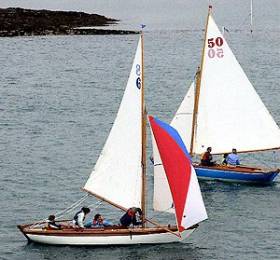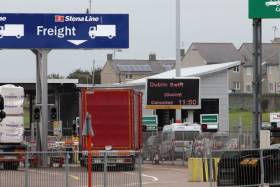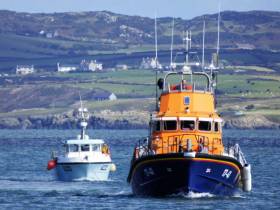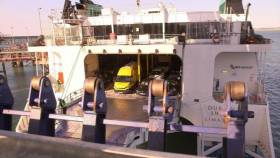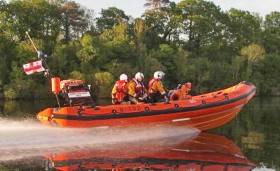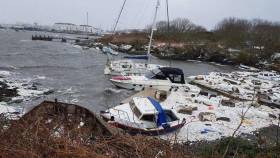Displaying items by tag: Holyhead
Trearddur Bay’s Myths & Seabird Half Raters To Cross Irish Sea For Dun Laoghaire Regatta
#VDLR - Trearddur Bay Sailing Club brings its centenary year celebrations to Dublin Bay this summer as a number of its Myth class and Seabird Half Raters will be making the trip across the Irish Sea for the Volvo Dun Laoghaire Regatta.
Myths are one of the original classes raced since the Holyhead club’s inception in 1919, with three of the 14-footers joining a fleet of five 12-foot Insects — three of the latter, the first boats built for the club, having been restored for the centenary.
While no original Myths remain from those days, the open boat class has seen a resurgence in recent years, and a modern Myth fleet at Trearddur Bay has grown to over 40 vessels.
Designed along the lines of the International 14 but inspired by what the club calls “a hotch-potch of ideas”, Myths are distinguished as much by their tight specification as their turkey red sails and either white-painted or varnished hulls that comprise five different types of wood.
With the Myth class now in its 99th year, its lasting legacy is no doubt also connected to the boat’s particular suitability to the environment of Trearddur Bay — not to mention the absence of an age barrier when it comes to racing, as young and old can compete on equal terms.
They are matched by the Seabird Half Rater — which was adopted in 1922 and is one of the oldest one-designs still sailing in British waters — at a club which currently has a strong dinghy scene with Mirrors, Fevas and Optimists among a full member list of more than 1,100 that sails every August.
Due to the uniquely short season, Trearddur Bay’s members regularly sail and race at other clubs, so some of the contingent will likely be no strangers to the waters of Dublin Bay as they join the likes of Olympic medalist Mike McIntyre at the biennial regatta — and Ireland’s largest sailing event — from 11-14 July.
The entry form for the Volvo Dun Laoghaire Regatta 2019 is available HERE. Early bird entry fees are available up to Sunday 31 March.
Plan By Protesters to Go-Slow And Holyhead Port Blockade - 'Will Continue' Until Brexit is Resolved
#ports - Plans for vehicle go-slows orchestrated by a north Wales man in protest at the UK Government's handling of Brexit are now expected to take place across the country.
As NorthWalesLive reports, The Brexit Protest and Direct Action Group, which is led by Deeside man Ian Charlesworth, has organised a go-slow protest on the A494 on Friday , March 22.
A second protest at Holyhead Port is also back on the agenda for this Saturday, March 23.
The intention is to cause disruption to Irish wagons heading toward Holyhead Port along the A55 - a main trading route with the EU, which the UK is set to leave on March 29.
For more including the political landscape click here.
No-Deal Disruption Says Brexit Minister at Holyhead Port 'Can Be Avoided'
#ferries - There have been calls for the UK Prime Minister to remove the threat of a no-deal Brexit have been repeated by the Counsel General and Brexit Minister Jeremy Miles, following a visit to Holyhead Port.
As ITV News reports, he met with the Port's manager, Captain Wyn Parry, who set out some of his concerns about operations in Holyhead if the UK crashes out of the EU without a deal.
Welsh ports are the gateway between Ireland and the rest of Europe, with 80% of goods carried in Irish-registered HGVs between the Republic of Ireland and Europe passing through Welsh ports.
Holyhead is the second busiest roll-on roll-off ferry port in the UK - providing the link in the supply chain for businesses across Wales, the UK and Ireland.
To read a comment by the Brexit Minister, click here.
Holyhead Lorry Backlog Plan in Case of No-Deal Brexit
#ferries - Parking sites in Anglesey, north Wales, could be turned into places for lorries to use in the event of a no-deal Brexit.
The contingency plan, led by the Welsh Government, reports BBC News, has been drawn up in case Holyhead port is unable to handle traffic after the UK leaves the EU (see story: Dover truck test on trade exercise held earlier this week).
It comes as MPs are expected to reject Theresa May's Brexit deal.
The two sites on Anglesey are at the Roadking truck stop, near Holyhead, and land adjacent to the Mona airfield in the centre of the island.
The plan has been drawn up amid concerns that additional border checks in the event of a no-deal Brexit on 29 March could lead to traffic problems at Welsh ports connected to the Republic of Ireland.
In order to avoid disruption in that scenario, the UK government has said that it would minimise checks or simply waive through trucks from EU countries, such as Ireland.
However, the EU has said it would impose full controls on people and goods entering the EU from Wales and the UK.
For much more on the ferryport story (click here) including reaction from truck-drivers and politicians.
Irish Fishing Vessel Rescued By Holyhead Lifeboat
#Lifeboats - Holyhead’s all-weather lifeboat launched yesterday morning (Saturday 29 September) to the rescue of an Irish fishing boat adrift in the Irish Sea with mechanical failure.
Pagers sounded for the Holyhead RNLI crew just after 8am following a distress call to HM Coastguard from the 10m potting vessel, which was some 21 miles northwest of Holyhead.
On reaching the stricken boat, the crew on the lifeboat Christopher Pearce set up a tow for the slow return to Holyhead. In all the lifeboat was five hours at sea.
Aafter ensuring all were well, the fishermen set off to return to Ireland on the next ferry, leaving their vessel to be repaired locally.
Holyhead coxswain Tony Price said: “The casualty craft and her crew were well-equipped. It’s always a shame for any craft or persons in difficulty, but it’s particularly sad when a vessel is earning her living from the sea, and we wish our Irish fishermen friends a speedy return to normality after their misfortune.
“I’d also like to send thanks to the local coastguard teams for helping with mooring the craft safely back in Holyhead.”
Reality Check: Brexit Dilemma In Port of Holyhead
#FerryNews- The locals in the north Wales Port of Holyhead call it hum: it's the sound of refrigeration units attached to lorry trailers waiting, 24 hours a day, seven days a week, for the next ferry bound for Dublin.
This small town on Anglesey reports BBC News, lies at the heart of one of the poorest areas in the UK. But it is also the second busiest roll-on roll-off ferry port in the country, a vital link in a seamless supply chain for businesses across the UK and Ireland.
Brexit, for which Anglesey narrowly voted in the 2016 referendum, could change everything.
Why? Because at the moment this is the quickest route across the Irish Sea - the sailing time from Dublin to Holyhead is just over three hours.
"At night-time," says Ian Davies, trade director for Stena Line, which runs Holyhead Port, "we have 400 to 500 articulated lorries coming off two ferries within 25 minutes of each other."
For much more including photos click here.
Enniskillen Lifeboat Rescues Two After Boat Breaks Free From Jetty During Storm Hector
#RNLI - Enniskillen RNLI rescued two people on Lower Lough Erne after their 42ft cruiser broke free from its jetty during Storm Hector yesterday morning (Thursday 14 June).
Belfast Coastguard requested the launch of the inshore lifeboat at 6.42am, with the volunteer crew proceeding north to the stricken vessel close to the shoreline south of Rossigh.
With increasing winds through the night, the vessel had broken free from its mooring and some of the jetty was still secured to the boat.
The winds were starting to settle but they were estimated to be Force 6 or 7 when launching from the Lough Erne Yacht Club.
The lifeboat managed to refloat the vessel and brought it into safer water. The hire company then took charge of the cruiser with the lifeboat accompanying them to a sheltered location.
“With challenging conditions this morning the crews training was put into action and brought the two people and vessel to safety,” said Gary Jones, Enniskillen RNLI’s lifeboat operations manager.
Elsewhere, pagers sounded across the Irish Sea at Holyhead RNLI just after midnight on Thursday in the midst of the storm, with reports of an 18-metre yacht with mechanical failure west of the Skerries lighthouse off Anglesey.
At the scene, the lifeboat crew found the 60-tonne vessel, with two on board, had lost all power and was struggling to cope with the weather conditions, including southerly gale-force winds and spring tides.
The lifeboat undertook a tow of the stricken yacht, which was returning from the Isle of Man TT races back to her mooring at Holyhead. Both vessels arrived safely in port at 4.30am.
Speaking on behalf of Holyhead RNLI, press officer Vicki Owens said: “The weather was unseasonably rough, but our dedicated crew left their beds to help someone in trouble.”
The surprise Storm Hector was also responsible for blowing a yacht ashore on the Kerry coast, as previously noted on Afloat.ie.
Paddle Steamer Bound For Ireland Sinks Near Holyhead
RNLI volunteers from Holyhead in North Wales were called to a paddle steamer sinking in the Irish Sea yesterday afternoon (Friday 25 May).
The vessel had been under tow by tug towards Ireland after a period in the south of England when it began taking on water some 10 miles west of South Stack.
Holyhead’s Severn class all-weather lifeboat Christopher Pearce was called at 2.20pm and launched immediately, arriving on scene within 40 minutes.
By that time, the 36m vessel was in trouble and beginning to sink from the bow.
The Holyhead lifeboat crew quickly ascertained that the paddle steamer did not have anyone on board, and did not contain any fuel.
A swift decision was made by Holyhead coxswain Tony Price that the situation was too dangerous to try and put any crew on board the stricken vessel.
Within half an hour, the vessel had sunk further into the sea, and at 4.20pm she sank completely into the 50m deep waters.
“It was very sad to see such a lovely vessel sink like that, but fortunately no one was endangered and the lack of fuel on board meant there were no environmental issues,” Price said.
More Holyhead Marina Wreckage Washes Ashore on Dublin Bay
Debris from the break–up of Holyhead Marina on the north coast of Wales continues to wash ashore along the County Dublin and Wicklow coasts.
Afloat.ie reader Peter Cunning found debris from on Sutton beach on Dublin Bay this week, which he believes came from the Storm Emma carnage at Holyhead.
"It's an interesting piece of coachroof from a Westerly, with hull plate no ST2", he tells Afloat.ie.
Holyhead Storm Debris Washes Up South Of Dublin
#Holyhead - Debris from Storm Emma’s damage to Holyhead Marina has been found across the Irish Sea south of Dublin, as North Wales’ Daily Post reports.
Polystyrene from pontoons destroyed during the extreme weather event over a month ago was found in Greystones by a group of sea cadets from Holyhead.
“I was a bit shocked and I apologised to the people of Greystones,” said Lt Susan Williams with the sea cadet group, who added: “They were all sympathetic to what had happened and said it couldn’t be helped. Nobody was gunning for Holyhead but it was embarrassing.”
Holyhead marina users have expressed dismay over the progress of the clean-up operation over the last few weeks. The Daily Post has much more on the story HERE.



























